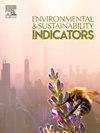Ecosystem health assessment based on the V-O-R-S framework for the Upper Ganga Riverine Wetland in India
IF 5.4
Q1 ENVIRONMENTAL SCIENCES
引用次数: 0
Abstract
Rapid land-use changes driven by anthropogenic activities have significantly deteriorated riverine wetland ecosystem health (WEH), underscoring the need for comprehensive ecosystem health assessment. While riverine wetlands play a critical role in sustaining human well-being and conserving endemic biodiversity, limited studies have explored WEH through an integrated lens of ecological factors and human reliance on ecosystem services. This study employs the Vigor-Organization-Resilience-Services (VORS) framework to assess the WEH, using the entropy weighting method to compute the wetland ecosystem health index (WEHI) based on NDVI, landscape metrics, and land-use/land-cover (LULC) coefficient indicators. Applying the framework to the Upper Ganga Riverine Wetland (UGRW) in India, the study examines ecosystem health over two decades (2000–2020). The findings reveal substantial land-use changes during this period, with a 245% increase in built-up and a 41% decline in forest cover. Consequently, the WEHI declined from 0.75 in 2000 to 0.58 in 2020, marking a 23% decrease over the period. All V-O-R-S indicators showed a downward trend, with ecosystem organization (O) showing the steepest decline of 45%, followed by ecosystem services (S) at 18%, ecosystem resilience (R) at 14%, and ecosystem vigor (V) at 8%. These changes reflect the significant impacts of wetland fragmentation and land-use transitions over time. The VORS framework provides a holistic perspective on WEH, offering crucial insights for stakeholders to design effective environmental management strategies. The findings can support policy measures aligned with Sustainable Development Goals (SDGs), prioritizing wetland sustainability and enhancing conservation efforts in fragile riverine ecosystems.

求助全文
约1分钟内获得全文
求助全文
来源期刊

Environmental and Sustainability Indicators
Environmental Science-Environmental Science (miscellaneous)
CiteScore
7.80
自引率
2.30%
发文量
49
审稿时长
57 days
 求助内容:
求助内容: 应助结果提醒方式:
应助结果提醒方式:


